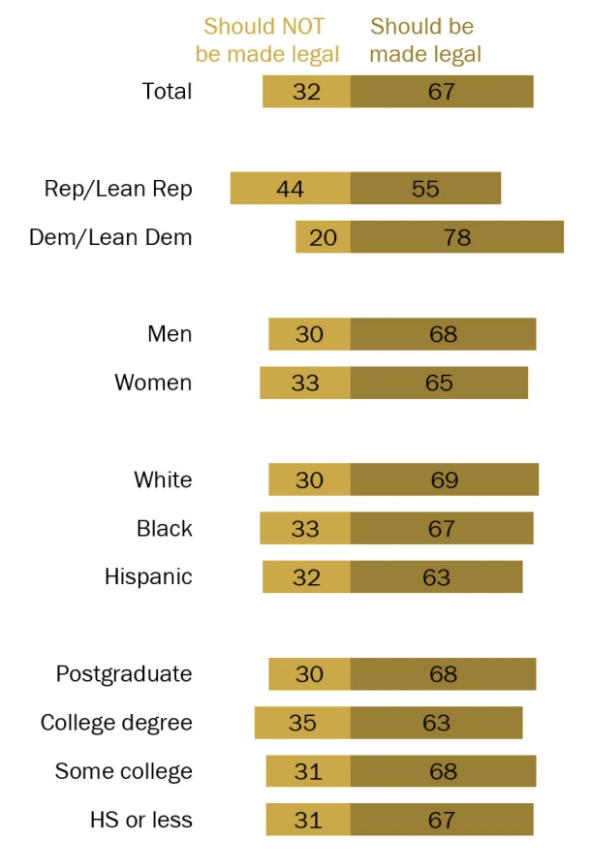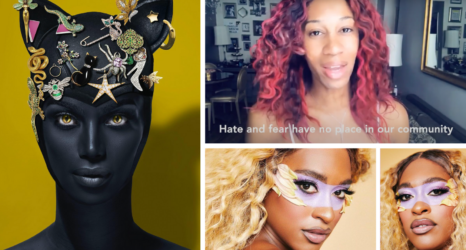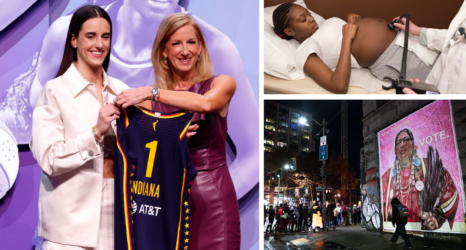On 4/20 Day, feminist conversations shift to the war on drugs and its disproportionate impact on Black and brown communities.
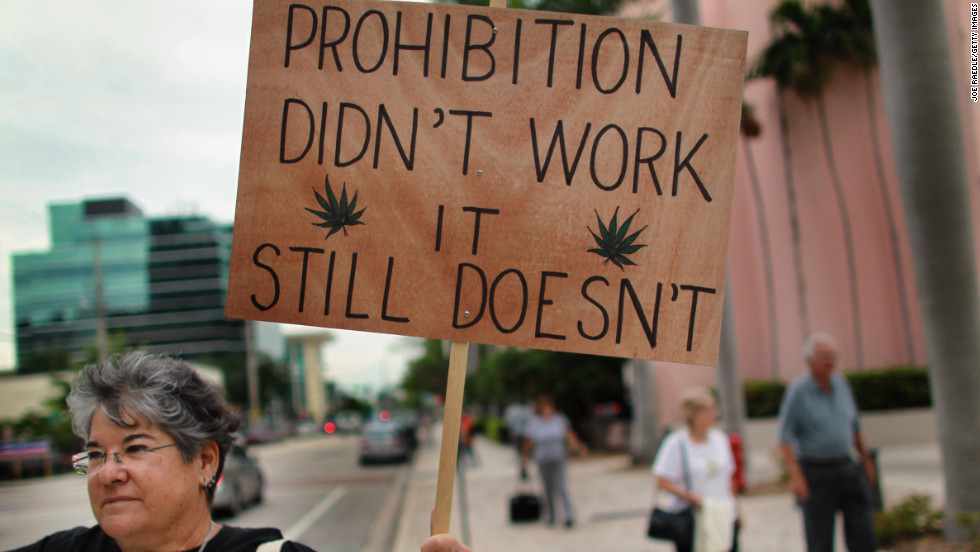
As many Americans consume cannabis without worry, misogyny and racism prevent minority communities from enjoying the 4/20 holiday—as they have since the beginning of the war on drugs in the 1970s.
1. The origins of the war on drugs are political—not scientific.
In the 1960s, with the culmination of the Civil Rights Movement, anti-Vietnam War protests and pushes for equality for women, a new counterculture had begun to materialize. For these groups, drugs like cannabis became synonymous with youthful rebellion, free love, social justice and political dissent.
Thus, the beginning of the U.S. war on drugs as we know it started with the presidency of Richard Nixon. He declared the “war on drugs” in 1971, and with that announcement brought a dramatic increase in the size and presence of federal drug control efforts, and pushed through measures like mandatory sentencing and no-knock warrants. (The police who shot and killed Breonna Taylor in March 2020 were able to enter her apartment with a no-knock warrant.)
Recently, one of Richard Nixon’s top advisers admitted the war on drugs was, at its core, a racist political tool. In 1994, former Nixon domestic policy chief John Ehrlichman told Harper’s writer Dan Baum:
“The Nixon campaign in 1968, and the Nixon White House after that, had two enemies: the antiwar left and Black people. You understand what I’m saying? We knew we couldn’t make it illegal to be either against the war or Black, but by getting the public to associate the hippies with marijuana and Blacks with heroin, and then criminalizing both heavily, we could disrupt those communities. We could arrest their leaders, raid their homes, break up their meetings, and vilify them night after night on the evening news.
“Did we know we were lying about the drugs? Of course we did.”
It’s clear, then, as Asha Bandele, former director at Drug Policy Alliance puts it, that during the war on drugs, “Drugs became a proxy for race.”
2. The war on drugs has devastated minority communities.
It is essentially impossible to overstate the harmful effects of Nixon’s drug policies. To put the damage of the war on drugs in perspective: When the war on drugs began in 1971, the prison population was 200,000. Today, that number is over 2 million.
According to the Drug Policy Alliance:
People of color experience discrimination at every stage of the criminal legal system and are more likely to be stopped, searched, arrested, convicted, harshly sentenced and saddled with a lifelong criminal record. This is particularly the case for drug law violations.
Nearly 80 percent of people in federal prison and almost 60 percent of people in state prison for drug offenses are Black or Latino.
Research shows that prosecutors are twice as likely to pursue a mandatory minimum sentence for Black people as for white people charged with the same offense. Among people who received a mandatory minimum sentence in 2011, 38 percent were Latino and 31 percent were Black.
Black people and Native Americans are more likely to be killed by law enforcement than other racial or ethnic groups. They are often stereotyped as being violent or addicted to alcohol and other drugs. Experts believe that stigma and racism may play a major role in police-community interactions.
And the effects go beyond jail time. Someone with a crime or incarceration on their record automatically becomes ineligible for most financial aid. Experts approximate that between 50,000 and 60,000 students per year are denied financial aid and federal education assistance, like Pell grants and student loans, due to prior drug convictions.
The video below, narrated by Jay Z and illustrated by acclaimed artist Molly Crabapple, further examines the drug war’s destructive impact on Black and brown communities due to years of racist law enforcement:
3. The war on drugs has had dramatic effects on women, especially women of color and low-income women.
“The war on drugs has become a largely unannounced war on women, particularly women of color.”
—Invisible No More: Police Violence Against Black Women and Women of Color
Over 61 percent of federally incarcerated women are there for nonviolent drug offenses—and Black women, Native American women and Latinas more likely to serve time than their white counterparts, according to the Drug Policy Alliance. These statistics persist despite the fact that “whites are nearly five times as likely as Blacks to use marijuana and three times as likely as Blacks to have used crack,” according to University of Michigan’s Andrea Ritchie, author of Invisible No More: Police Violence Against Black Women and Women of Color.
For poor women, especially poor women of color, police target women drug users according to the “broken windows” theory. Ritchie warns we must “pay particular attention to how controlling narratives inform broad exercises of police discretion and fuel police stops, harassment, violence, extortion, and arrests of women of color in the context of broken windows policing across the country.”
4. Despite equal rates of reported usages, it’s dangerous for women to admit to drug use.
According to a report from the Cannabis Consumers Coalition, cannabis consumption between men and women is about 50/50, debunking a common misconception that the majority of pot users are men. (The survey was anonymous and covered all states, not just those with legalized marijuana.)
Yet, the war on drugs broadly continues to disproportionately attack and overpower women, as shown by the Association for Women’s Rights in Development (AWID) report, “Feminist Movements and Women Resisting the War on Drugs.” “‘Coming out’ as a woman who uses drugs can be extremely dangerous to the safety and wellbeing of the woman and all those depending on her care—one heightened risk, for instance, is the loss of parental rights,” the report read.
Similarly, drug selling occurs at similar rates “across racial and ethnic groups, yet Black and Latina women are far more likely to be criminalized for drug law violations than white women,” according to the Drug Policy Alliance.
5. The marijuana industry is nowhere close to gender or racial parity.
While consumption between men and women is more or less equal, female representation on the business side of the cannabis industry still hasn’t caught up to match its equal representation at purchasing. In October 2015, Marijuana Business Daily reported 36 percent of executive-level roles in the marijuana industry were held by women. When the same survey went out in 2017, female execs had dropped to 27 percent, down 9 percent. (Still, that’s something to celebrate when compared to U.S. businesses as a whole, where women reflect only 23 percent of top positions and 5 percent of CEO jobs. Forbes writer Debra Borchardt attributes this healthy edge to “the relative youth of the industry.”)
In states that have legalized recreational cannabis usage, rates of ownership and entrepreneurship in the marijuana industry for people of color are abysmal: Less than a fifth of the people involved at an ownership or stake-holder level were people of color, a 2017 survey found; Black people made up only 4.3 percent.
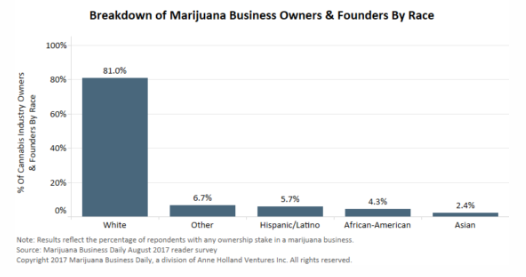
As more cannabis markets come online, many believe if meaningful action isn’t taken, the marijuana industry will continue down the path of most other businesses in the U.S.—where being white and male gives aspiring business-owners a significant advantage.
“The idea that a new, extremely lucrative industry [is] materializing—comprised largely of white males selling a drug that many people of color [have] been arrested and incarcerated for—[is] seen by many as an injustice,” writes Eli McVey in a report for Marijuana Business Daily entitled “Women and Minorities in the Cannabis Industry.”
Righting this wrong has been the impetus for a growing movement within the cannabis conversation: social equity initiatives—or the idea that regulators and leaders in the space have an obligation to right the wrongs of cannabis prohibition. Social equity in cannabis looks different depending on location, but it often takes the form of official city or county programs, general resources and educational materials, legal assistance, one-on-one counseling, record expungement and more.
As states make moves to legalize cannabis, we’re already seeing what happens when racial equity isn’t centered.
— ACLU (@ACLU) April 20, 2021
Disparities in arrest rates persist and, in some cases, have even worsened.
There can be no legalization without racial equity. https://t.co/AbH9kFp5a9
6. The war on drugs rages on.
As of 2021, 35 states plus D.C have legalized medicinal marijuana, and 15 states plus D.C. have implemented recreational usage of the plant. But the nationwide war on marijuana and the larger war on drugs still continues, affecting low-income communities and people of color the most.
Legalization is still the best path forward, but it’s not enough. The ACLU and other drug policy activists call for further action, like automatic record expungement for people incarcerated for non-violent cannabis convictions; and federal decriminalization and removal of the drugs from its Schedule One classification.
Two-thirds of Americans support marijuana legalization, and the issue has bipartisan support, especially among young people.
On Tuesday, Senate Majority Leader Chuck Schumer (D-N.Y.) told reporters to expect draft legislation to end federal prohibition on marijuana “in the near future.”
So, on this holiday, cannabis use reminds the nation about the power-hungry, patriarchal, racist nature of the continued war on drugs.
The coronavirus pandemic and the response by federal, state and local authorities is fast-moving. During this time, Ms. is keeping a focus on aspects of the crisis—especially as it impacts women and their families—often not reported by mainstream media. If you found this article helpful, please consider supporting our independent reporting and truth-telling for as little as $5 per month.



